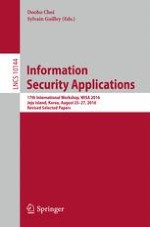This book constitutes the thoroughly refereed post-workshop proceedings of the 17th International Workshop on Information Security Applications, WISA 2016, held on Jeju Island, Korea, in August 2016.
The 31 revised full papers including two invited talks presented in this volume were carefully reviewed and selected from 61 submissions. The papers are organized in topical sections such as network security, threat analysis, application security, cryptographic. Protocols, cryptanalysis, cryptographic implementations, authentication using bio and ML, authentication, ICT Convergent security
